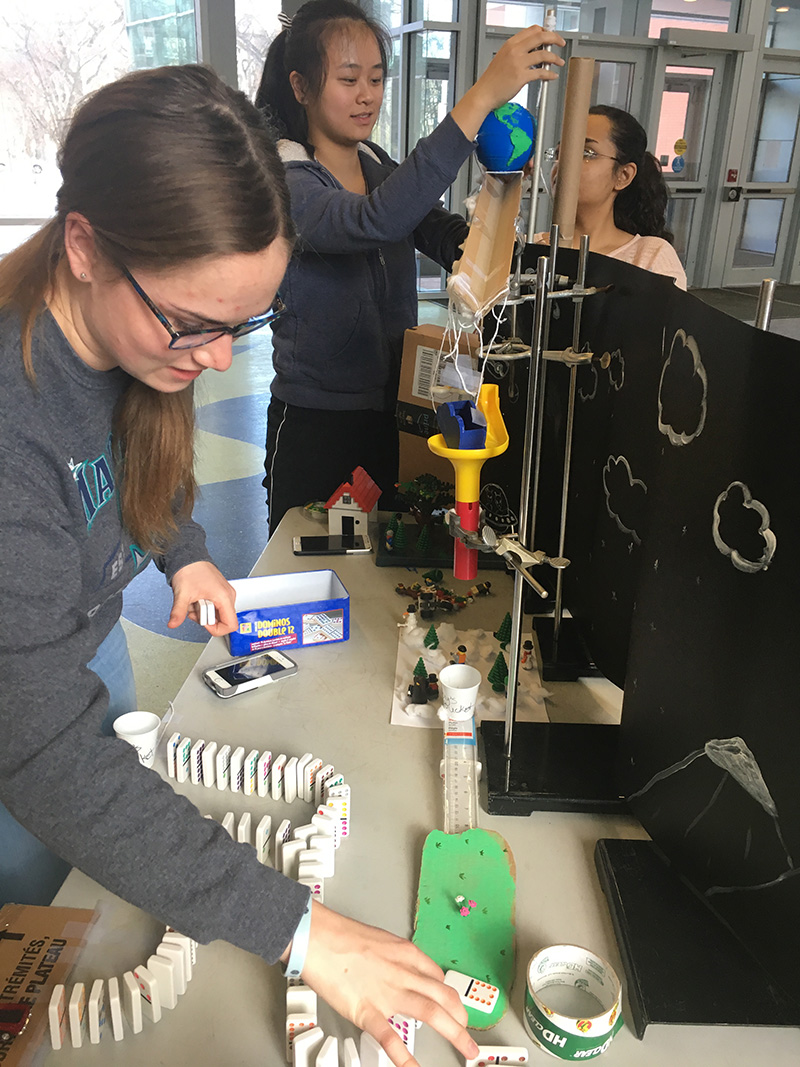
InSciTE students Hayley Karst, Kai Jun Ma, and Tanushka Anand (L to R) work on their section of the Rube Goldberg machine
Hear from undergraduate student Kai Jun Ma, who just completed her first year as an InSciTE student. InSciTE, or the Interdisciplinary Science Threshold Experience, is a unique program for first-year undergraduate students offered through the Faculty of Science.
As a student who was just finished the InSciTE program I have to say it was quite a grand ride. There were plenty of projects, from a gargantuan Capstone research project to writing a profile of an expert in science. However, in my opinion, the 3D printing project was the biggest pain in the butt.
Now you may be scratching your head and wondering how InSciTE was a great experience if the very project I chose to discuss here is a pain in the butt. Well, the answer is that the 3D printing project is also the most valuable thing I did in my first year. Why you ask? Hmm, this might take a few words. So, get on the train, take a seat, sip some tea, and let me tell you a story about how one school project almost turned a science student into an art student. In a good way, of course.
The Rube Goldberg Machine
On a sunny afternoon in January 2018, we were assigned the 3D printing project. I won't bore you with the details of getting handed homework, but I will summarize by saying that our task was to create a Rube Goldberg machine as a class. We were split into smaller groups of four to five people to build smaller stations/components of the machine using 3D printed objects. The stations had to link together and work as a whole machine. Our end goal? To make a cup of coffee for one of our instructors, Mike Kowalski.
Sounds easy enough, right? Well, sure it sounded so, but boy was there more in store for us.
To start off, each group had to choose a scientific theme. This project really tested our creativity and our ability to transfer that creativity into tangible results. After some brainstorming, our group settled on natural disasters. Other groups chose anything from the cell membrane, to statistics, to something out of this world (literally, since there was a couple of space themed stations).
Once the theme was decided, everyone got to work. Each person decided on the theme-related object they would print, and the actions associated with each object. This is where the SHACK comes in. The Science Hardware Hackerspace is a great resource full of wonderful people. Full of 3D printers and other cutting-edge technology, the SHACK is essentially a laboratory environment open for student use relating to all academic purposes.
After getting our objects printed, we got to building the machine. This took many late hours after lectures holed up in the InSciTE tutorial rooms and entire Saturdays cutting, gluing, and fixing in those same rooms. By fixing, I mean adjusting our machine here and there so that it would run smoothly. In all honesty, most of the time there was more hair pulling in frustration rather than actual fixing. But our team did not give up. Even though there were moments when we were all seriously considering flipping the table (especially when the dominos couldn't wait to fall over until after we finished setting them up), we still went at it little by little. After much brainstorming, complaining, and head banging, we finally got our machine to work. It really was a combined effort and looking back, I really appreciate having had teamwork in such dire times. Once our part of the machine worked, we thought the hardest part was over. Oh boy, were we wrong.
The beta test of the entire class machine was a disaster. In a Rube Goldberg Machine, one motion is supposed to lead to the next. In our beta test, almost all the separate stations had a problem with their motions. It was frustrating, and I even teared up a little, but the tears were far from those of frustration. In fact, our laughter only got louder with each failed motion. My favorite part was when the tank that was supposed to drive up a ramp to press the button of a coffee machine as a last motion just couldn't go up the ramp. It was like the little engine that couldn't. By this time, I was clutching my stomach and close to rolling on the floor while laughing. I heard the laughter of others and I had an epiphany of sorts. To say the beta test was an epic fail is a major understatement. Success was not in making the machine work, but it was in our growth. Many, if not all, of the groups have had enough trouble with their machine that we were all ready to be done with the project. But none of us gave up and we all persevered. What's more is that we were able to do it while having a great time, laughing, and looking on the brighter side of things.
The actual run of the Rube Goldberg machine was not much better than the beta test. But despite the hiccups, the machine had worked, even though it may have needed a push here and there. After months of preparations, planning, and execution, Mr. Kowalski got his cup of coffee.
Now that I have experienced InSciTE, I can say that I have gotten off that train prepared and anticipating the next ride to a new adventure. I cannot wait to see where it takes me and use the insights I have accumulated on this wonderful train ride over many ups and downs.